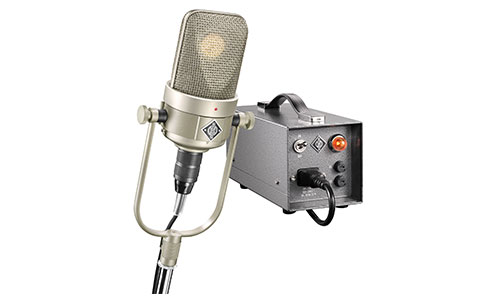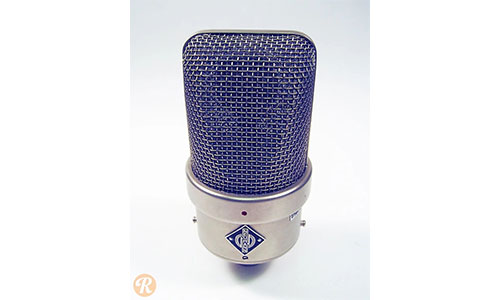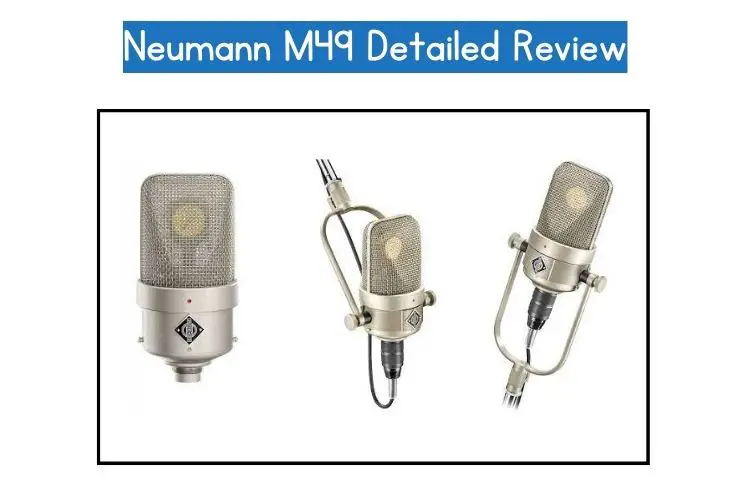When talking about some of the best microphone brands with exceptional sonic qualities, the name Neumann will always make it to the top of the list. Founded in Berlin, Germany by Georg Neumann in 1928, the name Neumann has become synonymous with excellence.
Although it might not exactly be that microphone found in the arsenal/cupboard of every recording engineer, it has still, however, found its way to the sonic palettes of many famous records and musicians—-both old school and contemporary.
Famous musicians/groups like Frank Sinatra, David Bowie, The Beatles, Chris Cornell, St. Vincent, Ed Sheeran, The Berlin Philharmonic, Ray Charles, Marvin Gaye, Stevie Wonder, Kurt Cobain, Jeff Buckley, Will.i.am, Amy Winehouse, Bruno Mars, Beyoncé and many others have used a Neumann microphone.
That being said, apart from famous models and brands like the Neumann U 47, the U 67, Telefunken ELA M 251, and the AKG C12, the Neumann M 49 remains one the most prestigious microphones ever made.
Despite the awesomeness of the M49, it is often not greatly talked about like other Neumann models and this might be because when the Neumann M49 was created, it was greatly marketed as a West German broadcast microphone rather than as a studio microphone.
The very first prototype of the Neumann M49 microphones was made as far back as 1949 for NWDR (Northwest German Broadcast); these prototypes were badged as B-M 49.
Aside from being an “instant hit” when first introduced and shipped in 1951, the M49 is the first studio microphone to have a continuously variable polar pattern; to this day, it is still greatly sought after by audio engineers and music producers worldwide.
In this article, we will go in-depth and talk about the famous and renowned Neumann M49 microphone. We will give an in-depth review and tell you everything you need to know about this rare gem, in case you are considering buying one.
Table of Contents
A Brief History of the Neumann M49
The Neumann M49 is a legendary microphone known for its incomparable, rich, and smooth tone. While it gained popularity for vocal recordings by artists like Barbra Streisand, Neil Diamond, and Huey Lewis, it was initially designed as a general-purpose microphone for the broadcast industry.
Before the M 49, changing the directional pattern of a microphone required replacing the entire microphone or its capsule head. The introduction of the Neumann U 47 in 1949 brought electronic switching between cardioid and omnidirectional modes.
However, the broadcast industry desired a microphone that could continuously switch between omnidirectional, cardioid, and figure-8 polar patterns, with remote control from the control room.
This flexibility allowed for choosing the best polar pattern for the listening environment, benefiting recording scenarios with limited microphones, such as recording orchestras or big bands.
Under Herbert Großkopf’s leadership, prototypes were created at Nordwestdeutscher Rundfunk (NWDR), and Neumann began manufacturing the M 49 in 1951 after obtaining the patent for its continuously switchable directional feature.
Despite being more expensive than the U 47, the M 49 quickly gained popularity due to its groundbreaking technology and balanced sound across all directional patterns.
It remained in production for an impressive 20 years, from 1951 to 1971, with final units hitting the market in the mid-1970s. Even today, the M 49 is highly sought after as one of the best studio microphones, particularly for vocal recordings.
Neumann M49 Frequency Response
The Neumann M49 tube condenser microphone produces a warm, smooth sound. With a little presence boost in the upper midrange and a mild roll-off in the high frequencies, its frequency response is typically flat.
The bass frequencies are well-extended, the middle is balanced with a light presence increase, and the high frequencies are smooth and detailed with a slight roll-off above 10 kHz.
Neuman M49 Specs
The Neumann M49 is a reproduction of the renowned microphone with enhanced detail;
- It is a versatile condenser microphone that may be used for voices and various instruments.
- It is handcrafted and hand-soldered in Germany and adheres to original specs based on archived documents.
- The microphone includes a pattern control mechanism that adapts to mains voltage automatically.
- The microphone uses a tube design and has a changing polar pattern.
- The M49 V microphone, NM V pattern control unit, KC 5 cable, shock mount, fast guide, and safety guidance are all included in the set.
- The microphone measures 6.4 inches long, 3.1 inches in diameter, and weighs 1.8 pounds.
- M49 features a 200 Ohm impedance, 40 Hz to 16 kHz frequency range, and a sensitivity of 6.5/8/10 mV/Pa 1 dB.
- The highest sound pressure level (SPL) (cardioid) is 125 dB.
- M49 is a traditional analogue microphone.
Neumann M49 Detailed Review
The Neumann M49 is a classic microphone that has made its mark on the audio industry. Its technical features and acoustic attributes make it a popular microphone among pros and fans.
The tube condenser design of the M49 adds to its warm and nostalgic sound signature. It has a reasonably flat frequency response, with a modest presence boost in the upper midrange and a moderate roll-off in the high frequencies.
This combination produces a smooth and natural sound reproduction, making it a popular choice for recording vocals and various instruments.
The M49’s variable-polar-pattern design is one of its distinguishing qualities. It enables the user to tailor the pickup pattern to their recording requirements.
This adaptability allows recording engineers to capture sound sources with varying polar patterns, such as cardioid, omnidirectional, and figure-8, broadening the range of applications.
The Neumann M49 is well-known for its superb sound quality, adaptability, and craftsmanship. When analyzing any microphone, examining its advantages and disadvantages is vital. Here are the Neumann M49’s advantages and disadvantages:
Pros
- The signature sound is vintage and warm, which makes it quite desirable to many.
- Variable-polar-pattern design is versatile.
- Outstanding build quality and craftsmanship
- Legendary performers have used it on famous recordings.
Cons
- When compared to other microphones, the price is somewhat high.
- Additional equipment (such as a high-quality preamp) is required to utilize its capabilities fully.
Neuman M49 Models
M 49V

The renowned M 49 multi-pattern tube condenser microphone that revolutionized studio recording in the 1950s and 1960s has been painstakingly reconstructed as the Neumann M49V.
Through careful testing and the use of archival documents, it has been created to sound just like the original M 49. Audio pros prize the M 49 V for its warm, smooth, and richly resonant tone.
The M 49 V produces outstanding results with acoustic instruments and as a room microphone, producing a lush and open sound.
It is a large-diaphragm tube microphone that excels at recording dramatic vocals. For various low-end qualities, it offers the option of a factory adjustment with a 30 Hz or 12 Hz high-pass filter.
A unique seven-pin connection that powers and enables smooth blending between omnidirectional, cardioid, and figure-eight patterns is used to connect the microphone to the Pattern Control Unit.
It can also be changed to operate in a cardioid-only mode with improved sensitivity and lower equivalent noise.
With upgrades for better signal-to-noise ratio, dynamic range, and interference rejection, the Pattern Control Unit automatically adjusts to various mains voltages.
A new subminiature tube and an RF-proof connector are used in these revisions to reduce noise and radio frequency interference, respectively.
The Neumann M 49 V offers remarkable detail and depth for high-quality recordings, bringing a famous microphone into the present era.
Neumann M 249

The Neumann M 249 is a large-diaphragm tube condenser microphone introduced in 1961 as the M49’s “broadcast” version. While the M 249 is quite similar to the M 49, it has a separate output connector for broadcast purposes.
The M 249 and the famed U 47 microphone differ significantly because the M 249 keeps the same sensitivity and output level across all polar patterns. A modification of the polarization voltage circuitry is used to achieve this.
The M 249 capsule’s two sides are always attached, unlike the U 47, whose connection or disconnection depends on the pattern chosen. The location of the pattern control on the power supply is then used to change the voltage between the two halves.
The PVC M7 capsule, also used in the original M49, was initially utilized by the M 249 system. Later iterations of the M 249 switched to the Mylar K47/K49 capsule, which was later adopted by other Neumann microphones.
The use of various capsule materials can affect the microphone’s overall sound and frequency response.
The tube used in the M 249 is a Telefunken AC701k subminiature tube. The tube selection can considerably impact a tube microphone’s warmth, saturation, and harmonic content.
Neumann M49b

The Neumann M49b tube condenser microphone is an improved version of the well-known M49 tube condenser microphone. With numerous enhancements to its look and functionality, it serves as a refinement of the original M49 model.
These improvements assure optimum performance in various recording circumstances and improve audio quality.
Additionally, the microphone might have component upgrades that use better capacitors, resistors, and other components in its internal circuitry.
These improvements improve overall reliability and sound reproduction. Additionally, improvements in manufacturing methods allow for tighter tolerances, more precise construction, and better longevity.
The M49b delivers a warm, rich, and detailed sound suitable for various recording applications, focusing on vocals and acoustic instruments.
It retains the core features of the original M49, including a large diaphragm capsule, switchable polar patterns, and tube-based circuitry.
The M49b represents an evolutionary step forward, offering improved performance and reliability while preserving the prized sonic qualities that have made the M49 a highly sought-after microphone for decades.
It may not be as well-known as the original M49 or Neumann microphones like the U47.
What is Neumann m49 used for?
The Neumann M49 is a well-known microphone used extensively in professional recording studios, radio and TV broadcasts, and sound reinforcement.
This makes it a top choice for recording various sound sources with precision and depth. When it comes to recording vocals, the M49 shines.
It gives a smooth, detailed sound that brings out the nuances and feelings in the singer’s voice. It can handle a wide range of volume levels, so even the softest whispers and the biggest shouts can be picked up clearly and accurately.
When it comes to musical instruments, the M49 does a great job of getting the real sound of acoustic instruments. The M49 accurately reproduces the natural timbres and dynamics of a grand piano, an acoustic guitar, strings, brass, and woodwinds.
Also, the M49 is often used to record ensembles because it gives a true representation of the sound of the whole group while keeping the separation and spatial imaging of each instrument.
It is a great tool for catching captivating live performances or studio recordings because it can pick up the subtle interactions between musicians and how the group sounds together.
The M49’s great sound quality is partly due to its tube-based circuitry, which gives the sound it records a desired vintage feel.
In short, the Neumann M49 is a highly regarded microphone because of its great sound quality, versatility, and ability to catch vocals, instruments, and other types of sound sources with great accuracy.
It is used in professional studios and has been used on many famous recordings, which shows how long-lasting it is and how much audio workers around the world respect it.
Who Used the Neumann M49?
The Neumann M49 has been utilized by several well-known performers and in several memorable recordings in various genres. Some noteworthy performers who have used the Neumann M49 include:
On his recordings, the M49 captured Miles Davis’ trumpet’s expressive and rich tones.
The M49 recorded Barbara Streisand’s powerful vocals, adding warmth and smoothness to her performances.
The M49 was a preferred microphone for recording Duke Ellington and his orchestra, allowing the sophisticated arrangements and dynamic range of the big band sound to be properly reproduced.
The M49 aided in the intimate and fascinating sound of Simon and Garfunkel’s folk-pop songs, amplifying their voices and creating a pleasant and engaging ambience.
On her first album, “Come Away with Me,” Norah Jones used the M49 to capture her seductive and soulful voice, providing depth and intimacy to her performances.
The M49 was popular for capturing Aretha Franklin’s powerful voice, allowing her to create deep and compelling performances with additional smoothness and richness.
These are only a few examples of the Neumann M49’s use by other artists and on innumerable famous recordings. Its warm and round tone and its ability to enhance vocalists and instruments have made it a favourite for capturing classic performances in various musical styles.
What is the Price of the Neumann M49?
A new Neumann M49 can cost anywhere from $5,000 to $8,000. The price can vary by several thousand dollars. But it’s important to remember that prices can change based on things like area, retailer, and any sales or discounts going on at the time.
Neumann M49 microphones that are old or used may also be for sale, and their prices can change based on their condition, age, and historical importance.
These old models, especially ones in good shape and with historical value, can sometimes get higher prices because they are rare, and people like the sound of the original M49.
Here is a list of a few shop prices:
| SHOP | PRICE |
| Miloco Gear | 15000 Euros |
| Vintage king | $8895 |
| Reverb | $16500 |
Why Are Neumann Mics So Expensive?
Neumann microphones are known for their exceptional quality, craftsmanship, and reputation in the audio business, which adds to their higher price point.
Several factors add to the expense of Neumann microphones. Firstly, they have been carefully planned and engineered, undergoing extensive research and development processes to ensure optimal performance and sound quality.
The handcrafted nature of Neumann microphones further adds to their cost, as skilled workers assemble and solder each microphone with meticulous care. High-quality components, such as specially designed capsules and carefully chosen electronic components, also increase their price.
Additionally, Neumann microphones face rigorous testing and quality control processes to ensure consistent performance and reliability.
The brand’s strong reputation, built over decades, and its association with top recording studios and pros add to the perceived value and demand, justifying the premium price.
Ultimately, Neumann microphones are considered long-term investments by professionals who value superior sound quality and reliability, reflecting the brand’s dedication to innovation and excellence.
Conclusion
Neumann makes the best mics in the world because they are the best at what they do. These mics are made for engineers and studio owners who work professionally.
So, if you want the best tube condenser microphone, the Neumann M49 would be a good choice.


![Kaotica Eyeball vs Fatboy: ALL You Need to Know [2023]](https://performerlife.com/wp-content/uploads/2022/05/Kaotica-fatboy-211x150.jpg)

![What Happened To “Chief Keef”? [Everything to Know About This Rapper]](https://performerlife.com/wp-content/uploads/2022/05/Chief-Keef-211x150.jpg)